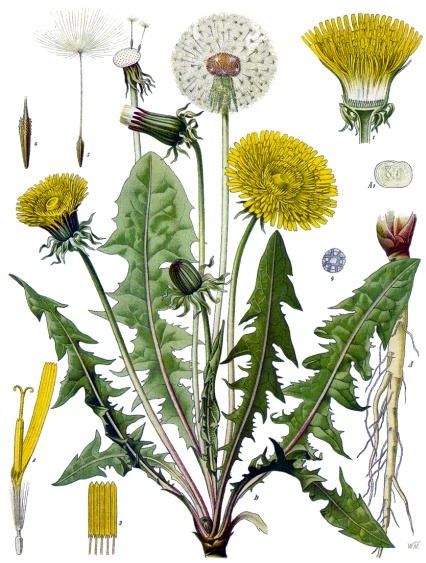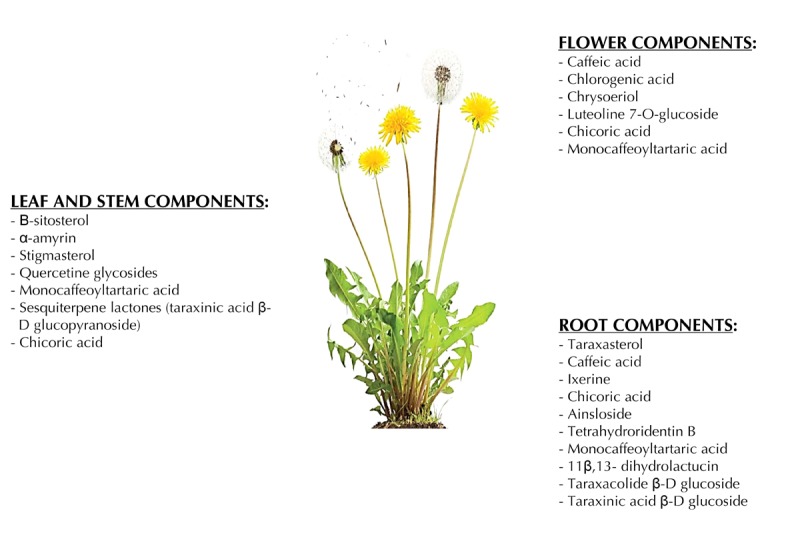DANDELION
Scientific name: Taraxacum officinale
Related species: Taraxacum mongolicum, Taraxacum palustre, Taraxacum vulgar
Other Names: Blowball, Cankerwort, Lion’s Tooth, Priest’s Crown, Swine Snout, Wild Endive, Canker Wart, Fairy Clock, Piss-in-Bed
Family: Compositae, sub-family Cichoroideae (Chicory)
Plant Distribution: Widespread in temperate Asia, Europe, and North America
Habitat: Dandelion grows in most temperate regions of Europe and Asia.
Dandelion is found growing wild in meadows, gardens, pastures, waste grounds, fields, sand, rocks, and even cracks in concrete.

Characteristics
Dandelion is a perennial herb that grows up to 18 inches. It has dark green leaves with toothed margin which grows in rosettes close to the ground. It has yellow flowers which opens in the morning and closes in the evening remaining closed all night and in dull weather. Dandelion is very easy to grow, it prefers moist soil and also the sun.
Dandelion’s active ingredients are found in both the roots and leaves. The leaves contain bitter sesquiterpene lactones such as taraxinic acid and triterpenoids such as cycloartenol. Dandelion leaves contains beta-carotene, vitamin E, riboflavin, folic acid, ascorbic acid, calcium, iron, protein, chicoric acid, luteolin, monocaffeyltartaric acid, and phenylpropanoids. The plant parts also contain bitter latex.

Bodily influence
Diuretic, tonic, stomachic, aperient, deobstruent. Dandelion is used as food and medicine.
Parts to use
Flowers, leaves, and roots (the whole plant).
Indication and Uses
Approved by Commission E for:
- Dyspeptic complaints
- Infections of the urinary tract
- Liver and gallbladder complaints
- Loss of appetite
Dandelion is considered one the most nutritious plants known. It contains minerals, trace elements and other healing and cleansing properties and a great nutritional asset for weight-loss and chronic disease programmes.
Dandelion root contains practically every known vitamin and nutrient and a number of other components. It is usually recommended in any liver and kidney treatment as dandelion is used to detoxify the liver, gallbladder and kidneys. The root also has moderate anti-inflammatory properties and is a mild laxative.
The leaves and flowers, and buds are all nutritious and can be eaten or used to make tea. The leaves are a liver tonic and because they are bitter, they may also be a digestive tonic. They are also quite effective as a diuretic. The root is also a tremendous liver tonic. It strengthens the flow of the bile, which helps the digestion of fats. It also has a mild diuretic effect.
Dandelion is also used for facial steams and herbal baths.
Food Use: Young leaves are added to salads, soups and stews; they are also boiled, steamed and sautéed. The flowers can be used to make wine or diced and added to herbal vinegars. The root can be grounded and used as a substitute for coffee.
Production
Dandelion herb consists of the entire dandelion plant gathered while flowering. It is air dried.
Preparation and Dose
Mode of Administration: Whole, cut, and powdered dandelion is available in the form of drops, tinctures, juice, and in compound preparations.
Preparation:
Tea: To make a tea, use 1 to 2 teaspoonfuls finely cut dandelion leaves with 150 ml boiled water; strain after 15 minutes and drink warm.
Decoction: To make a decoction, use 3 to 4 gm cut and powdered root per cup of water. Decoction, 2-4 ounces, up to 4 times daily.
Leaf as Standard Infusion, 3-6 ounces as needed.
Infusion: To make an infusion, use 3 to 4 gm cut herb per 1 cup of water.
Extract: For an extract, mix 1 part coarsely powdered Dandelion root with 8 parts of water and 1 part spirit of wine.
Tincture [Fresh Root, 1:2] 1/2 to 1 teaspoon. Strong [Tincture [Fresh Root, 1:2] 1/2 to 1 teaspoon].
Daily Dosage: When using a tincture, the recommended dosage is 10 to 15 drops 3 times daily. A cup of the freshly made tea can be taken mornings and evenings.
Root Fluid extract (Root or Leaf): [1:1, 45% alcohol] 30-60 drops up to 4 times a day.
Storage: It should be protected from light and moisture.
Dosage Capsules: Leaves- 5 “0’capsules 3 times daily.
Capsules: Root – 4 “O” capsules 3 times daily.
Research/Clinical Studies
Renal and electrolyte balance: Diuretic
Study: Dandelion is used extensively in traditional medicine as a diuretic. This has been supported in human and animal study. In a small study involving 17 volunteers, for all the participants there was a significant increase in the frequency of urination in the 5-hour period after the first dose. There was also a significant increase in the excretion ratio in the 5-hour period after the second dose of extract. The third dose however did not show the same changes. [1]
In rats and mice, dandelion leaf extracts had diuretic effects as potent as furosemide. [2] It was shown to have greater diuretic effects than other herbs such as equisetum and juniper berry [3].
Gastrointestinal/hepatic: Cholagogue, digestive aid and appetite stimulant, laxative, treatment of hepatitis B
Cholagogue: Dandelion has long been used to stimulate bile secretion [4].
Animal studies: Dandelion leaf extracts increased bile secretion by 40% in rats [5].
In French studies, giving dogs a decoction of fresh dandelion root doubled their bile output.
Digestive aid and appetite stimulant: Historically, plants with strong bitter flavours have been regarded as digestion and appetite enhancers. Dandelion has a bitter component called taraxacin which belongs to a class of chemical which have antiseptic, germicidal and expectorant effects. The levels of inulin in dandelion ranges from 2% in Spring to up to 40% in autumn [6]. Inulin serves as food source for the good bacteria.
Animal studies: In two Chinese studies of animals with gastric ulcers, gastric metaplasia and hyperplasia, dandelion-containing herbal combinations led to significant histologic improvement [7].
Coronary artery disease: Dandelion reduced the extent of atherosclerosis by reducing oxidative stress and serum TC, TG, LDL-C and raising serum HDL-C. Dandelion is beneficial in preventing hypercholesterolemic atherosclerosis and reducing risk factors for coronary artery disease [8].
Liver protection: Hepatoprotective effects of the extract of dandelion leaves were tested. These results suggest that the beneficial effects of EDL on NASH are mainly due to its antioxidant and anti-inflammatory activities [9].
Endocrine: Diabetes: Dandelion is a traditional European remedy for Type II diabetes. [10] The inulin in dandelion is useful in helping with blood sugar control and diabetes.
Animal studies: Dandelion roots in doses of 500 mg per kg body weight exerted moderate hypoglycemic effects in normal rabbits, but not those with experimentally induced diabetes . In both normal mice and those with experimentally-induced diabetes, dandelion extracts exerted no significant effect on blood sugar levels.
Antimicrobial: Antiviral
In vitro: Like many herbal extracts, dandelion demonstrated antiviral effects against human herpes virus, type 1 (HHV1) in vitro.
Treatment of hepatitis B:
The Chinese have relied on an herbal combination including dandelion in the treatment of hepatitis B infections. A Chinese case series reported that an herbal combination including dandelion was helpful in treating 96 adults with chronic hepatitis B infection.
Immune modulation: Immunostimulant
Animal studies: In Chinese studies of mice with immunosuppression secondary to scald burns, dandelion and five other herbs enhanced several measures of immune functioning.
Antineoplastic: Antitumor
In vitro data: Like many herbal extracts, dandelion has demonstrated antitumor effects in vitro.
Laxative: Dandelion’s historical use as a gentle laxative has not been thoroughly evaluated in modern studies In a case series of 24 adults suffering from chronic colitis, an herbal combination containing dandelion improved constipation, diarrhea and intestinal cramping in 96% of patients.
Reference(s)
[1] The Diuretic Effect in Human Subjects of an Extract of Taraxacum officinale Folium over a Single Day – https://www.ncbi.nlm.nih.gov/pmc/articles/PMC3155102/pdf/acm.2008.0152.pdf
[2] Newall, Carol A., Linda A. Anderson, and J. David Phillipson. Herbal medicines. A guide for health-care professionals. The pharmaceutical press, 1996.
[3] Veterinary Herbal Medicine. Susan G. Wynn, Barbara Fougère
[4] The Physiological Effects of Dandelion (Taraxacum Officinale) in Type 2 Diabetes – https://www.ncbi.nlm.nih.gov/pmc/articles/PMC5553762/
[5] Taraxacum officinale (PROSEA) – https://uses.plantnet-project.org/en/Taraxacum_officinale_(PROSEA)
[6] Herbs and Natural Supplements, Volume 2: An Evidence-Based Guide, Volume 2 p.273. Lesley Braun, Marc Cohen
[7] Herbalism, Phytochemistry and Ethnopharmacology. edited by Amritpal Singh
[8] Hypolipidemic and Antioxidant Effects of Dandelion (Taraxacum officinale) Root and Leaf on Cholesterol-Fed Rabbits – https://www.ncbi.nlm.nih.gov/pmc/articles/PMC2820990/
[9] Dandelion leaf extract protects against liver injury induced by methionine- and choline-deficient diet in mice. https://www.ncbi.nlm.nih.gov/pubmed/23256442
[10] The Physiological Effects of Dandelion (Taraxacum Officinale) in Type 2 Diabetes – https://www.ncbi.nlm.nih.gov/pmc/articles/PMC5553762/
DISCLAIMER: THIS WEBSITE DOES NOT PROVIDE MEDICAL ADVICE
The information, including but not limited to, text, graphics, images and other material contained on this website are for informational purposes only. The purpose of this website is to promote broad consumer understanding and knowledge of various health topics. It is not intended to be a substitute for professional medical advice, diagnosis or treatment. Always seek the advice of your physician or other qualified health care provider with any questions you may have regarding a medical condition or treatment and before undertaking a new health care regimen, and never disregard professional medical advice or delay in seeking it because of something you have read on this website.